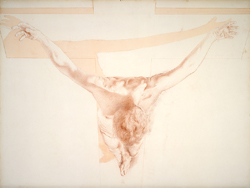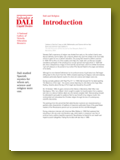
Salvador DALÍ
Spanish 1904–89, worked in United States 1940–48
The Ecumenical Council 1960
oil on canvas
299.7 x 254.0 cm
The Salvador Dalí Museum, St Petersburg, Florida
Worldwide Rights: © Salvador Dalí, Fundació
Gala-Salvador Dalí, VISCOPY, 2009.
In the USA: © Salvador Dalí Museum Inc.,
St. Petersburg, FL, 2009

Salvador DALÍ
Spanish 1904–89, worked in United States 1940–48
Christ in perspective 1950
red chalk
75.6 x 100.3 x cm
The Salvador Dalí Museum, St Petersburg, Florida
Worldwide Rights: © Salvador Dalí, Fundació
Gala-Salvador Dalí, VISCOPY, 2009.
In the USA: © Salvador Dalí Museum Inc.,
St. Petersburg, FL, 2009
Salvador Dalí’s experience of religion was divided from early on. His mother’s family were devout Catholics, but his father was a staunch atheist who sent him to the local state school to spare his son a Catholic education. The young Dalí shared his father’s aversion. In 1929-1930 his films Un Chien andalou and L’Age d’or, made with Luis Bunuel, included scandalous portrayals of the priesthood as corrupt, ignorant and hypocritical. In 1929 Dalí also drew a blasphemous image of Christ and the sacred heart, which he entitled Sometimes I spit with pleasure on the Portrait of my Mother (The Sacred Heart) to the anger and distress of his family.
Although he once blamed Catholicism for his profound sense of guilt about sex, Dalí’s attitude began shifting in America in the 1940s. He came to believe in the possibility of a fusion between modern science, the mystery of religion and the traditions of classicism and began painting his wife Gala as a Renaissance Madonna. In 1949 Dalí attended a private audience with Pope Pius XII. He announced himself a Catholic the next year, or (as he put it) a ‘Catholic without faith’. Dalí spent many of his later years reconciling Catholic dogma with science in ever-larger paintings. Afraid of death, Dalí hoped to avoid it altogether. Failing this he died with last rites in 1989.


